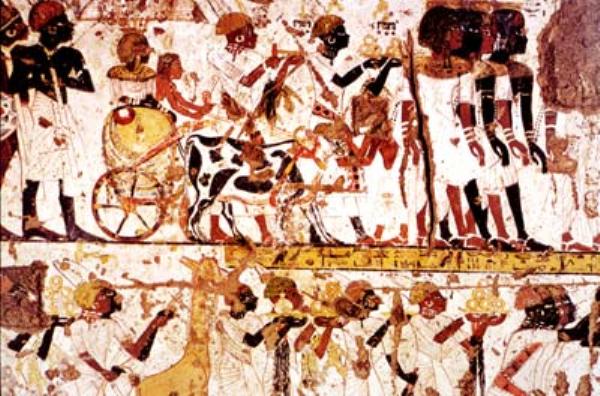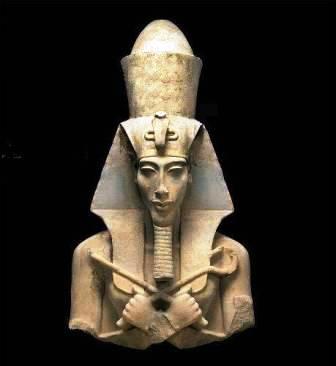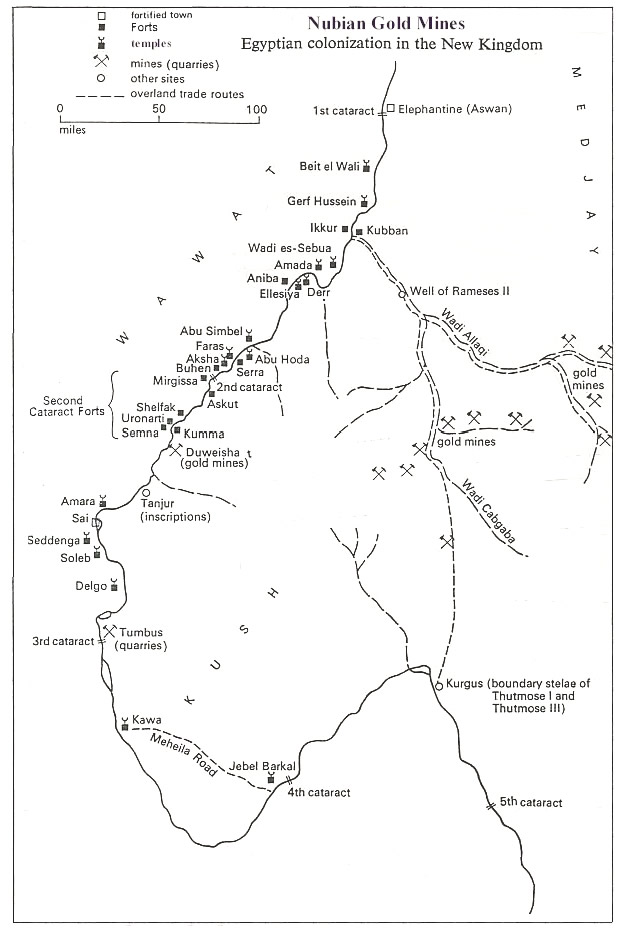Was the great African nation
of Nubia
the source of the Gold used
in the "Ark of the Covenant"?

Nubians Carrying Gold tribute into Egypt
Tomb of Huy, New Kingdom Vizier,
during the Reign of Tutmosis lll
The period of the New Kingdom in Egypt was a
golden era in the History of ancient Egypt.
The great personalities of this historic time
frame recorded in Egyptian art and literature compare favorably
with any personality in recorded history. The three most illustrious
rulers of the New Kingdom being Tutmose III, Hatshepsut, and Akhenaten.

Portrait of Akhenaten
The 18th and 17th centuries BCE had seen the
gradual occupation of the Egyptian Delta by immigrants called
the Hyksos, or foreign princes. The exact origins of these foreigners
is a debate among scholars of ancient Egypt however it was the
New Kingdom Rulers who solidified the southern Kingdom in its
trading and military alliances with Nubia enabling the New Kingdom
Rulers to overcome and expel the Hyksos from the Delta starting
with Ahmose I. The final decisive military campaign against the
Hyksos was conducted by Tutmose III. The story of the Hyksos,
their origins and their influences in Egyptian History is a story
to long to be told here.
At this time in the history of Ancient Egypt
there was a Renaissance of artisic expression highlighted by the
Armana Period. The portrait of Nefertiti in the Berlin Museum
is one of the classic portraitures of ancient Egypt.
.jpg)
Portrait of Nefertiti from the Armana Period
of Egyptian Art
This image has been restored
In photoshop
This portrait famous in all of the
world for its beauty was created in Armana during the reign of
Akhenaten. The richness of the art from this period is also represented
by the artifacts from the Tomb of Tutenkamen which is the only
tomb of a pharaoh found totally intact.

Semitic Nomads arrive in Egypt 1895 BCE
The historic sojourn of the Hebrews
in Egypt began in the Hyksos period see: Timelines
and Events of the Hebrew Sojourn.
The Hebrews living in Egypt during
the sojourn would have had some exposure to this art and many
may have been trained as craftsman and laborers in the classical
schools of Egyptian art. In the story of Joseph in the old testament
the Pharaoh mentioned that any Hebrews with particular talent
should be brought to his attention so they could be given special
training and promoted in their demonstrated skills.
What is important to realize is that the most
common source of gold used in ancient Egypt at this time in history
was derived from its trading association with Nubia. The very
name Nubia means gold. The hyroglyphic symbol for gold in the
language of ancient Egypt was also the root for the geographical
place Nubia.
At this time in the history ancient Egypt was
know to its diplomatic and trading partners as the source for
uncountable amounts of gold, a seeming enviable reputation to
have had and to occupy within the ancient world. The facts for
this reputation have been verified by the interpretation of the
Armana tables, the diplomatic letters and correspondence of the
first monotheistic Egyptian pharaoh, Ankenaten. The golden treasures
taken from the tomb of the New Kingdom Ruler Tutankhamen are also
testimony for the splendor that this source of gold allowed the
New kingdom artisans to create.
The golden treasures of Tutenkhamen's
tomb are also a testament to the likely appearance of the "Ark
of the Covenant" because, it is in Egyptian craft guilds
that the artisans who built the ark would have learned their trade/craft
prior to the Hebrew Exodus.

Craftsmen Guild Building Golden Shrines
illustrated in tomb of Rekhmire, New Kingdom
Ancient Egypt's Sources
for Nubian Gold During the New Kingdom

Map showing the sources for Nubian Gold During
the New Kingdom
and the time leading up to the Exodus
The map is from "Nubia: Corridor to Africa"
by William Yewdale Adams Princeton Univ. Press, 1977
